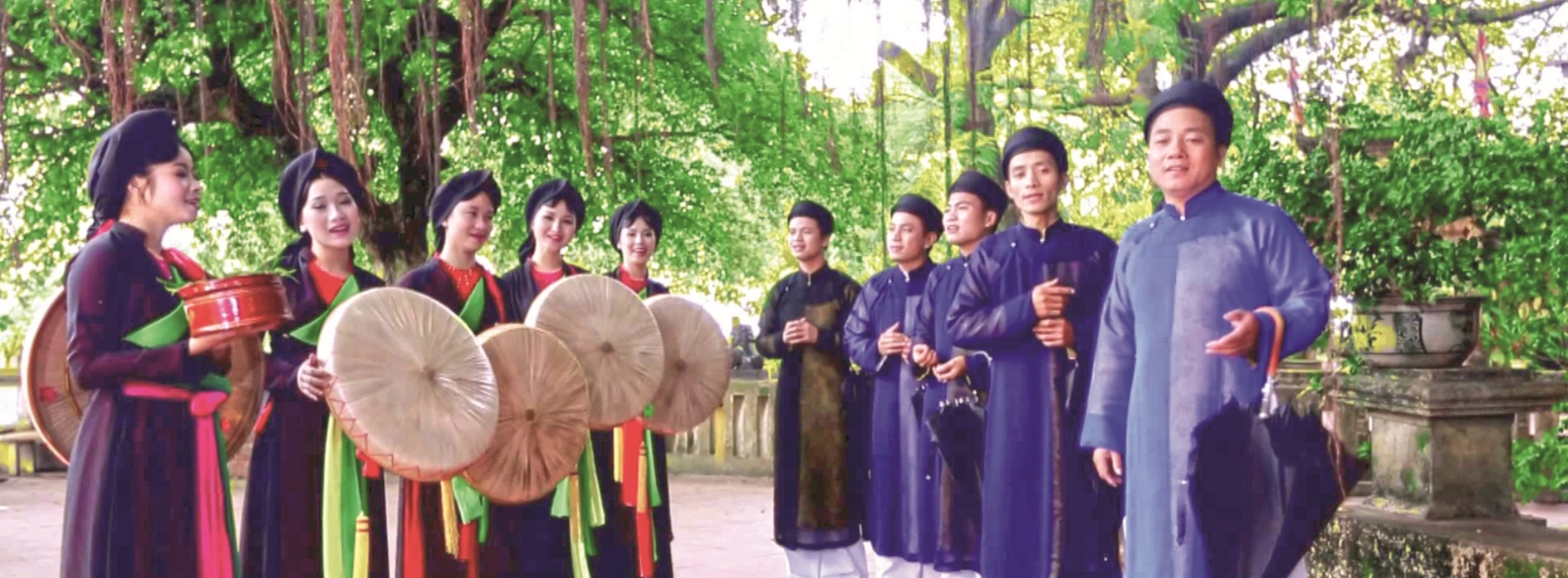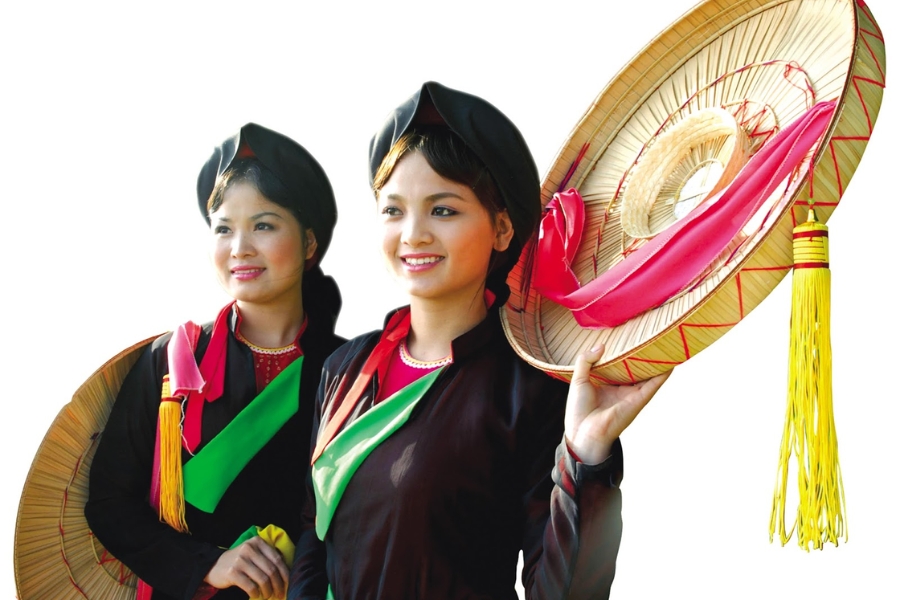
Quan Ho folk art is one of the melodies associated with the name of Kinh Bac. This is considered the pride of Bac Ninh people, and every tourist wants to learn about it when visiting this place. Instead of being recorded in books, Quan Ho folk art is passed down from generation to generation through word of mouth. Thus, to this day, Quan Ho is still a beautiful part of the cultural life of the people of Bac Ninh and Bac Giang.

Discover the Magic of Quan Ho Folksongs. Source: Bac Ninh News
Quan Ho folk songs are a famous art form in Vietnam since ancient times, popular in the Red River Delta in the North, becoming the pride of Kinh Bac people. This is an old province, including Bac Giang, Bac Ninh, part of Hung Yen, Lang Son, and Hanoi today.
Quan Ho folk songs are made up of many elements, such as music, costumes, and lyrics... all reflecting the colorful life of Kinh Bac people in the past. The most characteristic feature that visitors can see in Quan Ho is the way singing and between the brothers and sisters in costumes, including crow-beak scarves, shirts, and belts…
Folksong as a traditional form of art in some northern provinces. Source: Pinterest
Both sides will sing the same melody but differ in terms of lyrics and tone, while folk songs have up to 213 voices and more than 400 songs. Some famous quan ho folk songs that many people have probably heard are “Nguoi oi nguoi o dung ve,” “Moi trau,” and “Gia ban,” with profound lyrics, fully expressing the thoughts and feelings of our ancestors in the past.
Read more: Spring Spiritual Journey - Northern Vietnam's Sacred Festivals
Quan Ho folk song art developed strongly in Bac Ninh and scattered in a few places in Bac Giang, so when people mention Quan Ho, they often think of Bac Ninh. In Bac Ninh and Bac Giang, there are many ethnic groups living together, but uniquely, Quan Ho only exists in the Kinh ethnic community.
Without records, Quan Ho was passed down from generation to generation by word of mouth. Just like that, until now, no one knows exactly when and how Quan Ho folk songs appeared.
Origin of Quan Ho Folksongs. Source: Unsplash
Many people believe that Quan Ho originated from the royal court music when the two words "Quan" and "Ho" were separated. Others have passed down the story of a Mandarin who, when passing through Kinh Bac, was attracted by the singing of the brothers and sisters and had to stop (“ho”).
In 2009, along with Ca Tru, Quan Ho folk songs were recognized by UNESCO as an intangible cultural heritage of humanity. Currently, in the list of cultural heritage preservation and development, there are a total of 67 Quan Ho villages, of which Bac Giang has 23 villages, and Bac Ninh has 44 villages. However, UNESCO initially recognized only 49 Quan Ho villages.
In the art of Quan Ho folk songs, costumes are also an important factor that creates their uniqueness. Quan Ho costumes are not ostentatious but aim for elegance and formality but no less familiarity.
Costumes when singing Quan Ho. Source: Freepik
The brothers will wear ao dai, ao the, white pants underneath, a black turban, Gia Dinh shoes, and a Luc Soan umbrella in hand. The sisters will wear a three-layer ao dai, in which the outer layer is a thin ao dai covering the red and blue of the inner layer, creating a harmonious highlight. The belt is tied in a bow in front of the belly.
Another indispensable accessory of the sisters is a velvet scarf, a black crow-beak head scarf, skillfully tied into the shape of a lotus bud. In hand, they hold a large round conical hat. All create a traditional costume culture of Quan Ho folk songs of Kinh Bac region.
The materials used to make the elegant costumes of Quan Ho are mainly Ha Dong silk, Linh fabric, or satin. Even the headscarf shows the ingenuity of our ancestors when showing off the curly face of the sisters, while for the brothers, the turban follows the yin-yang rule, creating an impressive, elegant face.
Quan Ho folk songs have a moderate rhythm, mainly using 2/4 or 4/4 time. The rhythm is steady, not fast, flowing, and lyrical, with few cases of syncopation or punctuation. Most Quan Ho folk songs use single intervals, mostly minor thirds and fourths.
Rhythm and tempo of Quan Ho. Source: Shutterstock
Quan Ho folk songs have a very natural and gentle transition, mainly through level II, but there are still songs that go through level IV. An easily recognizable point in Quan Ho is that the poetic material of Nom stories, folk songs, proverbs, etc., is put into the lyrics a lot, so when listening to it, we will feel familiar and profound.
Quan Ho singing has many forms, such as worship singing, celebration singing, antiphonal singing, festival singing, and watch singing…, in which worship singing and Quan Ho antiphonal singing are the main and most popular forms of singing.
Antiphonal singing in Quan Ho can be male-female antiphonal singing, antiphonal singing, or antiphonal singing between male and female pairs... each with its own rules and manners.
In Bac Ninh Quan Ho folk songs, the female sings first, then the male responds, and so on for the entire singing session. When responding, the female side has a melody; the male side must also respond with the same melody. Regarding the lyrics, attention must also be paid and responded skillfully.
Quan Ho singing forms. Source: Istock
Only when both voice and words are responded, can it be called a complete male-female antiphonal singing performance. In general, Quan Ho antiphonal singing requires creativity and improvement in the poetic, musical, and technical skills of the artist.
In Bac Ninh Quan Ho folk songs, Quan Ho worship singing rituals are also an important popular form of singing, performed mainly in communal houses and temples on festival days to pray for favorable weather, good luck in business, and bountiful harvests, as well as to praise the merits of the village's tutelary gods and the saints worshiped in communal houses, pagodas, and temples.
When Quan Ho groups, both male and female, come to the village festival to sing for fun, each group must prepare betel, areca, and fruits for the ceremony. They will be warmly and solemnly welcomed by the village elders, then place offerings to the saints to the majestic and resounding sound of drums.
Quan Ho groups will sing a couple of songs to wish the saints and the people, as well as to pray for the gods to witness the friendship between the two Quan Ho villages so that they can have fun, travel, and sing Quan Ho properly. Once the Quan Ho worship singing rituals have been performed, the Quan Ho groups are loved and protected by the villagers. Thus, in Quan Ho, it is called worship singing.
Quan Ho singing forms. Source: Pinterest
Every year, in the spring, Bac Ninh people return to their hometown to attend the festival and listen to Quan Ho singing. Village boys and girls eagerly invite each other to sing, in pairs, at the communal houseyard, temple yard, and along the Cau River…
In particular, the Lim Bac Ninh festival has a solemn ceremony and a meeting with many folk games, which is the place to express Quan Ho culture most uniquely. The Lien Anh Lien Chi sings from the communal house gate, under the boat, on the stage... Coming here, you will have the opportunity to learn most deeply about this art form.
The artistic value and social behavioral value in Quan Ho lyrics express the desire for love between people, expressed in many emotional nuances: friendship and love between couples... along with the artistic peaks of poetry, the sublimation in Quan Ho music has become the main emotional and ideological content in the system of Quan Ho songs, contributing to creating the unchanging value of this type of music.
Above is information about Quan Ho folk art for those who want to learn about Kinh Bac land. Follow Asia King Travel to update more new destinations and unique cultural features for your next trip!
Read more: A Unique Cultural Art: Water Puppet Show in Vietnam